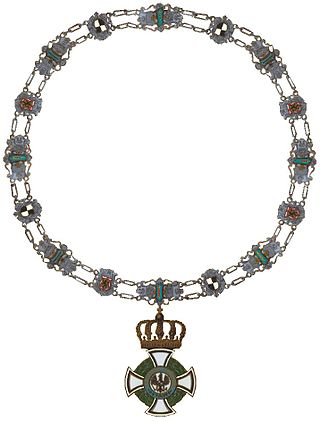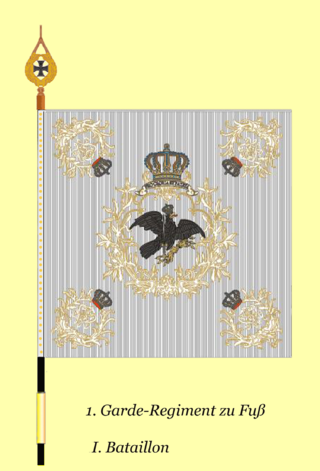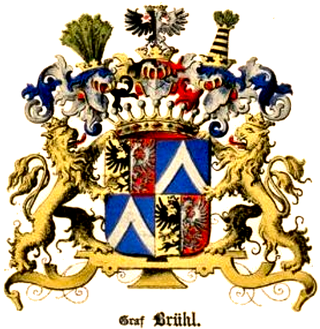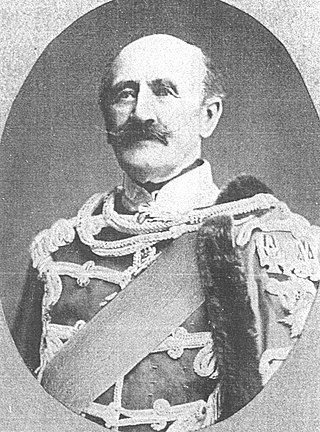


The Wasielewski family is a German noble family of Polish extraction. Members of the family held significant military positions in the Kingdom of Prussia and later within the German Empire.



The Wasielewski family is a German noble family of Polish extraction. Members of the family held significant military positions in the Kingdom of Prussia and later within the German Empire.
The Wasielewski family is Catholic and Protestant aristocracy, that commenced with Nicolaus Wasilewski recorded by King Sigismund I. of Poland in 1531. The Prussian line of the family begins with Thaddäus v. Wasielewski (1739–1803) with legitimation as Knights on 26 November 1789.
The family coat of arms "ROGALA" shows two horns, a buck horn and a buffalo horn. Both horns are standing upright. The buck horn has from 3 to 6 ends. The buffalo horn also described as a Bull or Wisent horn, is closed or open with a mouthpiece as a war or hunting horn. The horns are upright in a split shield. The family colours are red and white.

The Pour le Mérite is an order of merit established in 1740 by King Frederick II of Prussia. The Pour le Mérite was awarded as both a military and civil honour and ranked, along with the Order of the Black Eagle, the Order of the Red Eagle and the House Order of Hohenzollern, among the highest orders of merit in the Kingdom of Prussia. The order of merit was the highest royal Prussian order of bravery for officers of all ranks.

The Order of the Black Eagle was the highest order of chivalry in the Kingdom of Prussia. The order was founded on 17 January 1701 by Elector Friedrich III of Brandenburg. In his Dutch exile after World War I, deposed Emperor Wilhelm II continued to award the order to his family. He made his second wife, Princess Hermine Reuss of Greiz, a Lady in the Order of the Black Eagle.

The House Order of Hohenzollern was a dynastic order of knighthood of the House of Hohenzollern awarded to military commissioned officers and civilians of comparable status. Associated with the various versions of the order were crosses and medals which could be awarded to lower-ranking soldiers and civilians.

The German ancient noble family of Pfuel arrived in Brandenburg in the year 926 and later widened their influence to Saxony, Saxony-Anhalt, Mecklenburg, Pomerania, Württemberg, Westphalia, Eastern Europe and Sweden.

The 1st Foot Guard Regiment was an infantry regiment of the Royal Prussian Army formed in 1806 after Napoleon defeated Prussia in the Battle of Jena–Auerstedt. It was formed by combining all previous Foot Guard Regiments and was, from its inception, the bodyguard-regiment of Kings of Prussia. Save William II, who also wore the uniforms of other regiments, all Prussian Kings and most Princes of Prussia wore the uniform of the 1st Foot Guard Regiment. All Princes of Prussia were commissioned lieutenants in the 1st Foot Guards upon their tenth birthdays. The King of Prussia was also the Colonel-in-chief of the regiment, as well as the Chief of the 1st Battalion and 1st Company of the regiment. Therefore, the regiment held the highest rank within the Prussian Army, which, among other things, meant that the officer corps of the regiment marched before the princes of the German Empire and the diplomatic corps in the traditional New Year's reception. Unofficially, the regiment was known as the "First Regiment of Christendom".

The Order of Merit of the Prussian Crown was an award of civil and military merit established 18 January 1901 by King Wilhelm II on the occasion of the bicentennial of the establishment of the Kingdom of Prussia. The order was presented in one class and consisted of a badge and a breast star. For military merit the award was presented with crossed swords. The order was presented once with diamonds.

Alexander Friedrich Adolf Heinrich von Zastrow was a Prussian general who served in the Austro-Prussian War and the Franco-German War.

Carl Heinrich von Wedel was a Prussian lieutenant general in the War of Austrian Succession (1740–1748), the Seven Years' War (1756–1763), and the War of Bavarian Succession (1778–1779). He fought most notably in the Battle of Tornow in 1758, and the Battle of Kay in 1759. He was instrumental in Frederick the Great's victory at Leuthen in December 1757.
Friedrich Wilhelm Ernst Freiherr von Gaudi (Gaudy) was a Prussian Lieutenant General who served Frederick the Great in the Seven Years' War.

Schlieffen is the name of an old German noble family from Pomerania. The family, branches of which still exist today, originates in Kolberg.

Brühl is the name of an old German noble family from Saxony-Thuringia, with their ancestral seat in Gangloffsömmern in Thuringia. Branches of the family still exist today.

The House of Wedel is an old and distinguished German noble family, from Stormarn in what is now Schleswig-Holstein. The family members held the title of Prince, Count and Baron.

Jean de Forcade de Biaix, aka Jean de Forcade, Marquis de Biaix, aka Jean-Quirin de Forcade de Biaix, aka Jean Quérin von Forcade, Herr von Biaix, aka Johann Querin de Forcade, Herr zu Biaix, aka Johann Quirin von Forkade de Biaix was a Huguenot, a descendant of the noble family of Forcade and Lieutenant General in the service of the Kingdom of Prussia. He was the Regimentschef of the 23rd Prussian Infantry Regiment, Commandant of the Royal Residence in Berlin, Gouverneur militaire of Berlin, a Knight of the Order of the Black Eagle a member of King Frederick I of Prussia's "Tobacco Collegium". and president of the Grand Directoire 1718–1729, the deliberative and decision-making body responsible for all Huguenot affairs in the kingdom.
Friedrich Heinrich Ferdinand Leopold von Forcade de Biaix, aka Heinrich Friedrich Ferdinand Leopold von Forcade de Biaix, aka Friedrich Heinrich Ferdinand Leopold Marquis de Forcade de Biaix, was a Royal Prussian lieutenant colonel. He served in the Prussian Army from 1761-1793. His last command was as Commanding Officer of the 10th Prussian Fusilier Battalion, with which he served in the Rhine Campaigns of 1791, where he was awarded the Kingdom of Prussia's highest military order of merit for heroism, Knight of the Order of Pour le Mérite (1791). He left the Prussian Army after 32 years of service in 1793 as the result of invalidity. At the time of his death, he was the owner of Schleibitz Manor, near Oels, Silesia.
Friedrich Wilhelm von Forcade de Biaix, aka Frideric Guillaume de Forcade was a Royal Prussian Colonel, Schwadronschef of the 2nd Grenadier Company in the 24th Prussian Infantry Regiment, recipient of the Kingdom of Prussia's highest military order of merit for heroism, Knight of the Order of Pour le Mérite (1774), Commandant of Frankfurt/Oder, and Presbyter of the French congregation of Frankfurt/Oder.
Friedrich Wilhelm Ferdinand Ernst Heinrich von Forcade de Biaix, aka Ferdinand von Forcade, Royal Prussian Major and Knight of the Iron Cross 2nd Class.
Karl Georg Heinrich Bernhard von Poten, known as Bernhard von Poten, was a royal Prussian colonel best known for his military writing.

The House of Knesebeck is the name of two branches of a prominent aristocratic family in the tradition of the ancient nobility in Germany. In the 17th century they acknowledged a common ancestry and combined their arms. The black line of the family von dem Knesebeck stems from the ancient nobility of Lower Saxony, while the white line stems from the ancient nobility of the Altmark. Branches of both lines remain to this day. As one of the leading Prussian Junker families, it has produced numerous senior military and public figures. These have included ambassadors, bishops, governors, members of parliament, a field marshal, and dozens of generals.

Heinrich Wilhelm von Horn was a Prussian Lieutenant general who fought in the Napoleonic Wars.

Otto Rudolf Benno Hann von Weyhern Sr. was a Prussian General of the Cavalry during the First Schleswig War, the Austro-Prussian War and the Franco-Prussian War. He commanded the 2nd Cavalry Division during the Battle of Königgrätz.